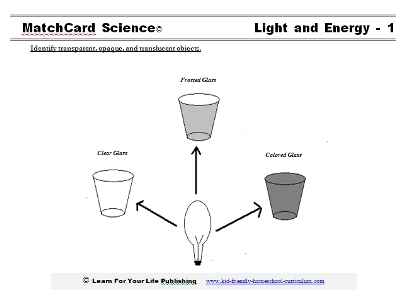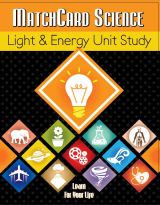Transparent versus Translucent
Identify Translucent, Opaque, and Transparent Objects
Demonstrate characteristics of transparent versus translucent versus opaque objects.
Free Download Below


Translucent, Transparent, Opaque
Objective: Identify transparent, translucent, and opaque objects.Most students have no difficulty recognizing transparent (clear) objects and opaque (non-transparent) objects. But translucent is somewhat in-between.
Download the
Transparent, Translucent, Opaque MatchCard


This is MatchCard #1 of the Energy Unit Study.
Find more information on MatchCard Science below.
Definitions of Transparent, Opaque, and Translucent
Give the students the following definitions:- Transparent - Light passes through
- Opaque - Light does not pass through
- Translucent - Some light passes, but is diffused in different directions.

Hands-On Activities for Transparent, Translucent, and Obaque
Match Dishes and Cards
Take one of the following sets of items:- Drinking glasses - clear, frosted, and solid colored mug
- Bowls - clear, translucent storage bowl, and solid colored
- Paper - clear kitchen wrap, waxed paper, construction paper or aluminum foil sheet
The Hunt
Look around the room and name objects that can be seen that are either transparent, translucent, or opaque.The opaque list will likely be the longest.
Then, have them name items they can think of that are transparent or translucent. Likely, transparent will the longer of the two.
Next, have them go on a hunt for other translucent objects. Often, the bathroom and kitchen are good places to find translucent containers.
Finally, have them make an on-going list of translucent objects they find over a one month period. See how long it takes to get to 20 objects.
Shining-Through: A Test
Have a set of items (such as the glasses, bowls, or paper listed above) on a table. You will want at least 2 to 3 of each type.You will also need a large book or other stand-up divider to block the students' view.
A flashlight or other light source is needed.
Here is how to do the translucent object test:
The room does not need to be completely dark, but it helps to turn off or dim the lights so the flashlight beam can be easily seen.
Put the objects behind the book, so they are not seen.
Shine the flashlight on a clear object, so it goes through the glass, and the beam can be seen by the person on the other side of the book.
Then, shine the flashlight on the translucent object. Can they tell the difference?
Take turns shining the light on different objects. The student needs to guess which it is.
Transparent to Translucent
Use one or more of these objects which you are going to change from transparent to translucent:- Transparent tape
- Clear kitchen wrap
- Clear plastic page protectors
- Overhead transparencies (yeah, they still make them.)
Read Through Water
You will need:- A clear glass filled with water
- A light, sunny room
- A newspaper or bendable paperback book (that you don’t mind getting a little wet)
Apply Transparent, Translucent, and Opaque to Art
If you go to an art store (or shop online) you may notice two types of water color paints:- Semi-transparent
- Semi-opaque
Water Color Paints
Water color paints are made of paint pigments floating in - you guessed it - water! Water is transparent (basically) and the pigments are not. The higher the percentage of water, the more transparent the paint is. Feeling artistic: try painting a water color picture. Of course, there are the very cheap water color paints for young kids and the more expensive ones sold at art stores. There will be a difference in the quality of your paint.Apply Transparent, Translucent, and Opaque to Human Anatomy
Now that you know about transparent, translucent, and obacity; let’s apply it to the human body. Look at another person. What part of their body that is visible is transparent, translucent, or opaque?- Opaque: skin
- Translucent: finger nails and toe nails
- Transparent: cornea
Vision, Opacity, and Cataracts
Of course you want a transparent cornea and lens. Cataracts occur if the lens becomes translucent or obaque. Do an internet search for “cataract vision” and look at the images.MatchCard Science
How To Use MatchCards

Download the FREE MatchCard Science Instructor's Guide and see how MatchCards can make building their science knowledge base fun.
Light and Energy Unit Study

Download the entire Light and Energy unit study.
12 Science Unit Studies

Chemistry is only one of twelve complete unit studies for kids in 3rd to 8th grade.
Comprehensive objectives, hands-on projects, suggested science fair experiments, and the fun game-like MatchCards keep them interested in learning science. See all twelve MatchCard Science Unit Studies.
About Our Site
Hands-On Learning













